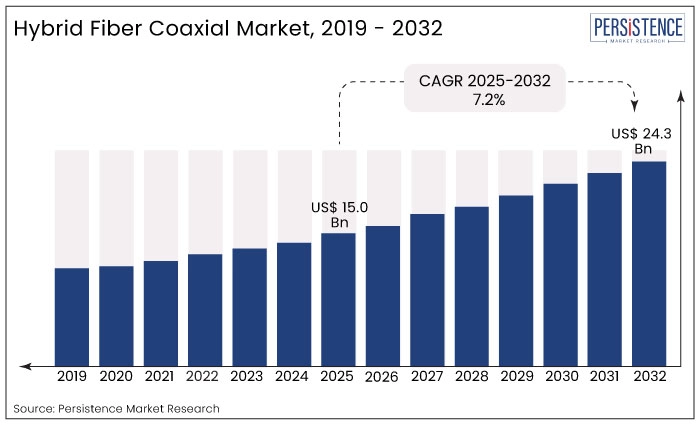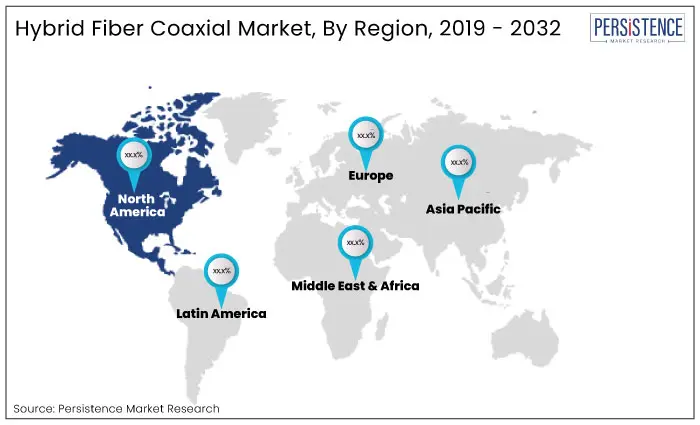ID: PMRREP27778| 297 Pages | 8 Jul 2025 | Format: PDF, Excel, PPT* | Semiconductor Electronics

The global hybrid fiber coaxial market was estimated at US$ 13.9 Bn in 2024 and is expected to reach US$15.0 Bn by 2025, growing at an annual CAGR of 7.2% from 2025 to 2032. According to estimates, the market will reach US$24.3 Bn by 2032.
Hybrid fiber-coaxial cables (HFCs) combine the advantages of fiber optic and coaxial cable-based transmission to form a unified path for communication. Digital interactive solutions and services are delivered to consumers and organizations through the Internet, voice, cable TV, and other services.
Compared with coaxial cables, hybrid fiber cables can carry a greater amount of data at a time. The higher bandwidth of HFC facilitates the efficient and interactive transmission of data. Due to their higher efficiency, fiber optic cables are more reliable and trustworthy than coaxial cables. Due to their usability and reliability, HFCs are an excellent choice in changing environments.
Providing a connection between cable TV and phone companies in close geographical proximity can be more efficient and powerful with fiber optic cables. Newer generation broadband networks utilize Fiber-to-the-Home (FTTX) and Hybrid Fiber Coaxial (HFC). Compared to each other, these technologies work differently in terms of how they transmit information, provide capacity for services, and maintain their systems.

|
Report Attributes |
Details |
|
Hybrid Fiber Coaxial Market Size (2025) |
US$15.0 Bn |
|
Projected Market Value (2032) |
US$24.3 Bn |
|
Market CAGR (2025 to 2032) |
7.2% CAGR |
According to Persistence Market Research, the global hybrid fiber coaxial market is expected to grow at a 7.2% CAGR from 2025 to 2032. The market registered a 7.5% CAGR in the historical period from 2019 to 2024.
Streaming services are also driving the demand for HFC networks as their popularity continues to grow in the market. Fast and reliable delivery of content is achieved by streaming services through high-speed connections. The capability of HFC networks to provide these services makes them an attractive option for service providers.
HFC networks are also being driven by the trend of cord-cutting. Increasingly, providers are delivering content via HFC networks as more people abandon traditional cable subscriptions. Expansion of existing networks will quickly overwhelm any short-term savings from future upgrade expenses and maintenance costs.
The ever-growing demand for data further drives the need for faster and more reliable networks. Due to their ability to transmit high-speed data, HFC networks are attractive options for service providers. Faster networks will only become more popular as people stream media, play video games, and work from home on the internet.
Hybrid Fiber Coaxial (HFC) networks are becoming increasingly necessary as high-speed Internet access becomes more prevalent. With HFC networks, users can access multiple services simultaneously through a single coaxial cable that supports data, voice, and video signals. In addition to making broadband more accessible and cost-effective, this technology is gaining in popularity in the market.
Growing demand for more bandwidth and faster speeds drives trends in the HFC industry. A rise in internet usage has contributed to an increased demand for more efficient HFC networks as internet usage increases. The use of new technologies increases connection speeds, ensures better customer service, and offers higher speeds. The emergence of 5G networks will also drive the need for HFC networks to be deployed in the near future.
Developing 5G networks requires faster speeds, larger bandwidths, and more reliable connections. As these services can be delivered at a cost-effective rate, HFC networks are well suited for handling these applications
Emerging Infrastructure and IT Sectors will drive growth
Hybrid fiber coaxial sales in North America are expected to reach US$ 4.9 billion by 2025. The United States and Canada are key contributors to the market's growth. A large number of HFC solution and equipment providers operate across the region, which contributes to the growth of the market.
With the widespread availability of the Internet in the United States, residential and commercial customers have access to broadband Internet, cable television, and telephone services through hybrid fiber coaxial systems (HFC).
The United States dominates the hybrid fiber coaxial market in North America. According to estimates, the country will account for 86.80% of all sales in 2024. Many IT and telecom firms and key market players are expanding their operational capacities for hybrid fiber coaxial.
The availability of high-quality infrastructure and the growth of the IT sector has raised a demand for hybrid fiber-coaxial cable. A growing number of data centers and cloud servers has contributed to the market's growth.
Expanding Telecommunications Industries to Drive Market Share
Hybrid fiber coaxial market revenues in Asia Pacific are expected to accumulate a revenue share of 24.6% over the forecast period. The rapid urbanization, population growth, and industrial expansion are all contributing to this growth.
Customers are shifting to high-speed internet connections and cost-effective solutions, which has led to the growth of the hybrid fiber coaxial market. China uses the most hybrid fiber coaxial in the world. Globally, China is responsible for 32% of manufacturing sales, and this figure will only increase in the future.
The manufacturing and industrial sectors in China are undergoing significant growth. Due to this development, fiber coaxial solutions are becoming increasingly popular in the region due to their affordability. Thus, hybrid fiber coaxial sales in China are projected to increase by US$ 1.7 billion over the next few years.

Increasing Consumer Demand to Provide New Services will increase the Popularity of Hybrid Fiber Coaxial
According to market projections, hybrid fiber coaxial demand for digital TV is expected to grow at a CAGR of 6.8% over the next few years. Digital TV is delivered via hybrid fiber coaxial (HFC) technology, which uses both optical fiber and coaxial cable.
Broadband data, video, and voice services can be delivered to end users using this combination of fiber and coaxial cable. Customers can access digital television, high-speed internet, and voice services through HFC networks offered by cable television providers.
Improved telecommunications infrastructure has led to an increase in consumer acceptance of new telecommunications services, such as digital television. Internet connectivity and amenities like digital television are driving businesses to develop hybrid fiber-coaxial infrastructure. Increasing consumer willingness to adopt new services, such as digital television, has led to the growth of the hybrid fiber-coaxial market.
CMTS/CCAP are Expected to Boost Demand for Hybrid Fiber Coaxial
The hybrid fiber coaxial market is expected to be dominated by CMTS/CCAP throughout the forecast period. It is expected that the market will grow at a CAGR of 6.9% over the forecast period.
With more individuals streaming videos and working from home, high-speed internet demand has increased. Over HFC networks, CMTS/CCAP can offer higher internet rates compared to conventional cable modems.
CMTS/CCAP provides service providers with a cost-effective solution since it can handle phone, video, and data services. A hybrid fiber coaxial system is projected to hold the largest market share in the coming years. The technology enables high-speed internet connectivity, enables several services to be provided, increases bandwidth and capacity, and provides future-proofing to the network.
Companies in the electronics industry are forming strategic partnerships with hybrid fiber coaxial manufacturers. They aim to expand their product range, increase their technological capability, and expand their market presence as part of their strategy to increase their market share. Innovative products could be developed by these companies when their strengths are combined.
Research and development are major investments for some companies to enhance their products' performance and capabilities. Launching new products is also one-way companies seek to gain a competitive advantage.
According to estimates, the global hybrid fiber coaxial market was worth US$ 13.9 Bn by 2024.
Hybrid fiber coaxial sales are expected to generate US$15.0 Bn in revenue in 2025.
Globally, the market for hybrid fiber coaxial is expected to reach US$24.3 Bn by 2032.
The hybrid fiber coaxial market is expected to grow at a CAGR of 7.2% during the forecast period.
According to a PMR, hybrid fiber coaxial sales grew 7.5% between 2019 and 2024.
Digital TV sales will account for a significant revenue of 6.8% CAGR by 2025.
China's hybrid fiber coaxial is forecast to grow at a CAGR of 7.9% over the forecast period.
|
Attribute |
Details |
|
Forecast Period |
2025 to 2032 |
|
Historical Data Available for |
2019 to 2024 |
| Market Analysis Units | Value: US$ Bn/Mn, Volume: As applicable |
|
Key Countries Covered |
|
|
Key Market Segments Covered |
|
|
Key Companies Profiled |
|
| Report Highlights |
|
|
Customization & Pricing |
Available upon Request |
By Component
By Application
By Region
Delivery Timelines
For more information on this report and its delivery timelines please get in touch with our sales team.
About Author